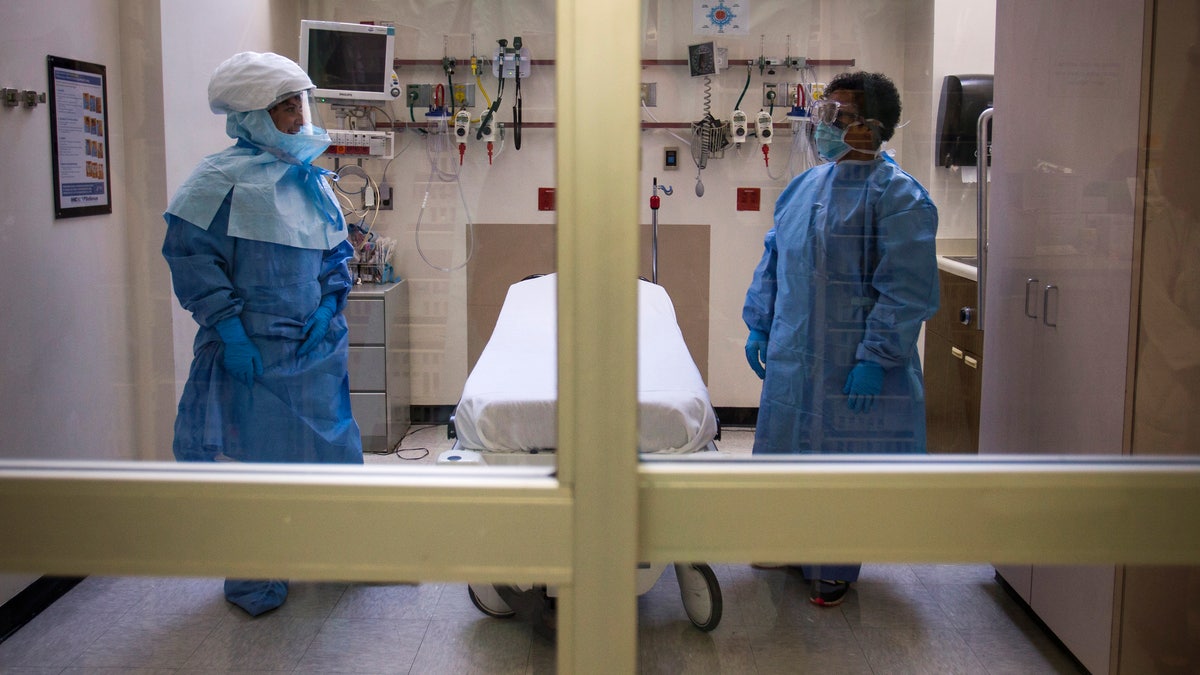
Health care workers display protective gear, which hospital staff would wear to protect them from Ebola infection, inside an isolation room as part of a media tour in the emergency department of Bellevue Hospital in Manhattan, New York October 8, 2014. REUTERS/Adrees Latif
After a nurse who cared for the Ebola victim in Dallas tested positive for the disease Sunday, questions have arisen as to the protection and training of health care workers.
Unlike the nursing assistant in Spain who reportedly became infected after touching her face with her protective glove, the Texas health care worker— who is said to have worn full personal protective equipment— has said she doesn’t know how she contracted the disease.
In a press conference Monday, Centers for Disease Control and Prevention (CDC) director Dr. Thomas Frieden said the CDC is investigating the situation at Texas Health Presbyterian Hospital, including use of personal protective equipment, but they have not identified a specific incident that led to the infection.
“[We’re] not going to wait for final results of that investigation… each time we identify a process or training or equipment or protocol that can be improved there, we are improving it right on the site,” he said.
Staff at Texas Health Presbyterian are now watching as workers put on an take off protective gear and are being retrained in doing that safely, Frieden said. The CDC is also looking at types of personal protective equipment to see if some may be easier to put on or take off, thereby reducing the risk someone would unintentionally contaminate themselves. They’re also considering spraying down workers with decontaminant as they exit isolation units, which was already standard for gloves.
Frieden noted that there is the potential for possible other cases, including other health care workers who worked with Ebola patient Thomas Eric Duncan, when he was ill.
“All of us have to work together to do whatever possible to reduce the risk any other health care worker becomes infected,” he said.
All health workers treating an Ebola patient should wear personal protective gear, the CDC says. The exact gear can vary. A hazardous material-type suit usually includes a gown, two sets of gloves, a face mask, and an eye shield. There are strict protocols for how to use these tools correctly.
The Ebola virus, which is transmitted through bodily fluids of an actively ill patient, is not highly infectious, but breaches of protocol in the removal of personal protective equipment can increase risk.
“This is a pathogen that’s not forgiving,” Dr. Amesh Adalja, infectious disease specialist at the University of Pittsburgh Medical Center, told FoxNews.com. “So if you have a breach in protocol, you’re really doing a virus a favor, because it’s still not a very contagious disease … the virus really has no avenue of infecting you unless it finds a breach.”
Caring for a patient who is in the advanced stages of disease may increase risk.
“I think concern for transmission goes up if you’re taking care of someone in the advance stages of the disease when the amount of virus shedding in bodily secretions is really high,” Dr. Amar Safdar, associate professor in the department of medicine, division of infectious diseases and immunology at NYU Langone Medical Center, told FoxNews.com. “Even a minor breach could then potentially expose an individual to a large quantity of virus.”
When removing gear that has been contaminated, health care workers must be extra cautious to not touch any uncontaminated part of their faces, clothing, or protective layers, Dr. Jeffrey Duchin, chief of communicable disease epidemiology and immunization of public health in Seattle and King County, Washington, told FoxNews.com.
“It’s really important that health care workers are trained and then observed,” he said. “First trained thoroughly in these techniques, also observed in all times while using, while taking personal protective equipment off, to identify any potential issues.”
Removing personal protective gear can be difficult after a long shift in possibly uncomfortable, sweaty gear, Adalja, a member of the Infectious Disease Society of America's (IDSA) public health committee, noted.
One solution may be to have a second person watching the health care workers remove their gear, as Doctors Without Borders has done in West Africa.
“I think for something that can potentially be this serious, having someone else observe someone going in and coming out and advising them on how to take stuff off, know it’s cumbersome and time-consuming, but I personally think time and resources would be well spent if there is supervision within the group,” Safdar said.
With the case of the infected health care worker in Texas, the fact that there has only been one transmitted case, of the many health care workers and family who had close exposure to Duncan, shows the low rate of infection, Safdar noted.
“That just tells you that it is not easily passed on to other people; that is a living example of what really happened right here,” he said. “The concern is not the protective gear and protocol in place are deficient in some way, [I] think they are time-tested, so to speak, and do work, but if a breach in those protocols, that’s when someone is exposed and potentially can develop infection.”
Hospital workers are accustomed to and trained in working with communicable diseases and using gloves, a gown and a mask are standard protocol for infectious disease control, experts noted.
“It’s not something that we see once a week, it’s something we do on almost on a daily basis — think about how to prevent spread of infections by people getting admitted [to] a hospital because they need hospital care,” Safdar said.
The Associated Press contributed to this report.
